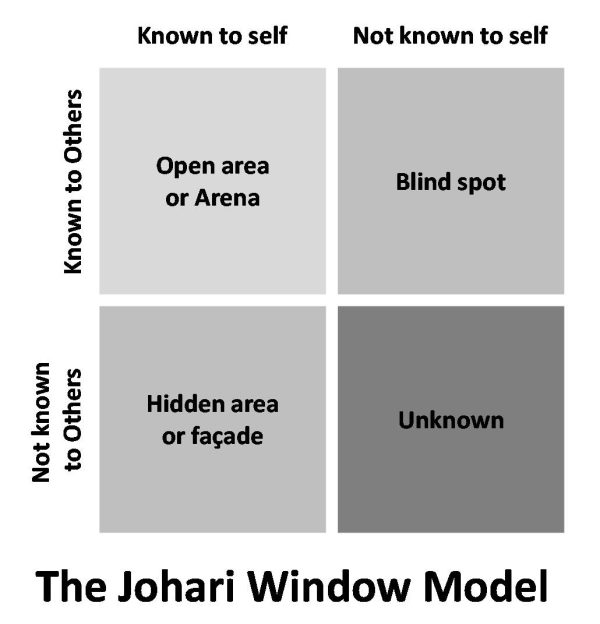Origins
The Johari window model was developed by American psychologists Joseph Luft and Harry Ingham in the 1950s, while they were researching group dynamics. Today the Johari window model is especially relevant because of the modern emphasis on soft skills, behavior, empathy, cooperation, inter-group development and interpersonal development.
Interestingly, Luft and Ingham called their Johari window model Johari after combining their first names, Joseph and Harrington. In early publications the word actually appears as JoHari. The Johari window became a widely used model to understand and train self-awareness, for personal development, to improve communications, interpersonal relationships, group dynamics, team development and inter-group relationships.

The model
Johari window model is sometimes called: a disclosure / feedback model of self awareness. Basically, Johari window is an information processing tool. It helps enhance individual’s perception on others. This model is based on two ideas that you can:
- Acquire trust by revealing information about yourself to others, and
- Learn more about yourself from their feedback
Johari window represents such information as feelings, experience, views, attitudes, skills, intentions, motivation, etc. from four perspectives.
These perspectives capture assessments pertaining to a person or about that person’s relation to their group:
Arena
What the person knows about him / herself and others. Examples include the person‘s name, hair / eye color, etc. This is the main area where most communications occur. The larger the arena, the more effectual and dynamic the relationships are. Feedback solicitation helps extend the arena horizontally and decrease the blind spot. You can also extend the arena vertically by revealing one’s feelings to other person and reducing the hidden / unknown areas.
Blind Spot
What is unknown to the person, but that others know. Examples include the person’s manners, observable habits, feelings of other persons about the person, etc. Others may interpret your actions differently than you expect them to. Seeking feedback from others helps reduce the blind spot.
Façade
What the person knows about him / herself, but that others don‘t know. Examples include the person’s secrets, hopes, desires, likes and dislikes, etc. These are any personal information that you are reluctant to reveal. You want to keep such information private as it may affect your relationships. You may decrease this hidden area by revealing such information at your discretion.
Unknown
What neither the person, nor others know about the person. This information has an unknown potential to influence the rest of the Johari window. The person will be unaware till he / she discovers the hidden qualities and capabilities or through others’ observations. Open communication is also effective to decrease the unknown area and communicate effectively.
In the beginning of a communication process, when you meet someone, the size of the Arena quadrant is not very large. This is because there has been little time and opportunity to exchange information. The general rule of thumb is that you should try to expand the Arena to become the dominant window, thus demonstrating transparency, openness and honesty in interactions. When you do this, the other party will also probably open up.
Applications
The Johari window is generally used for teaching and considering and administering an understanding how individuals:
- Communicate with themselves and with others
- Present themselves to themselves and to others
- Perceive their place in the world
With a little consideration, Johari is also suitable for multiple usage as a:
- Coaching tool to to facilitate conversations around actions vs. perceived motivations
- Organizational Development tool to visualize the political and cultural issues that may be in or out of sync within a business
- Management tool to demonstrate team dynamics
- Self-development tool that helps to consider one’s own behavior vs. reaction
Advantages
- Easy to grasp, flexible outcomes
- The method catalyses open information sharing
- The method will create a shared reference point
Disadvantages
- Some people may pass on the information they received further than you desire
- People prefer not communicating some information (g. sexual preference, mental / health issues, significant failures)
- Some people may react negatively




